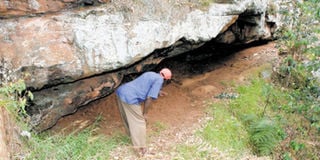Four wonders of the Manga Hills

The Manga caves start from top of the cliffs on the Nyamira side and end in Kisii county. Photo/SULEIMAN MBATIAH
They are home to four hidden cultural sites that remain untapped and which are awaiting the new county government to place on the tourist trail.
The Manga chain of hills which divides Kisii and Nyamira has the centuries old caves, Ngurumuaga.
It has a waterfall at Ensoko, which has been turned into a spring to serve the local people.
This has the potential to become a commercial mineral water that can be packaged and branded under the Nyamira county logo – the same way as the current Kiringeti mineral water.
Then, the third big attraction is Lake Okari, while the fourth is natural a group of holes in the rock surface with which locals play the game ajua.
The myth around the small lake goes around that there was once a house belonging to the family of Okari.
Top of the cliffs
“A flood came and it was swallowed beneath earth but the family had left for safety,” said Mr Samwel Nyandika.
All the three natural phenomena are atop a range of cliffs dropping down about 100 metres.
The top of the cliffs is in Kitutu Masaba constituency in Nyamira and the bottom flat land is in Kitutu Chache in Kisii.
Christopher Nyangweso, 81, has seen it all at the caves. They are culturally significant to the Gusii people.
“In the olden days, elderly women came here at night to mark every harvest,” he said.
They would sing Gusii songs, ululating in praise of the good harvest that would chase away hunger.
Then, men would follow with amarua (traditional alcohol) to drink, thanking God for the good harvest.
The young initiates would also go to the caves to discard beddings they used while healing after circumcision.
The initiates would be made to go round the caves as a sign of graduating to adulthood.
The caves, it is said, start from the Nyamira side and open at the bottom on Kisii side.
And when strangers visit them, upon leaving, they are made to tie a knot in local grass before the entrance to appease the spirits so that they do not haunt them.
Mr Nyangweso recalled that Europeans used to go to the caves around 1948 for sight-seeing and to make merry.
“They would come and slaughter goats here to enjoy watching animals and birds,” he recalled.
Tourists still troop to Manga to see the wonders of nature.
Currently, porcupines and other animals inhabit the caves.
The holes engraved in a slab of rock are used by locals to play the game ajua… but they have no earthly origin.
“It is God who made it, we did not come here with a hammer and chisel to engrave these holes,” said Mr Nyangweso.
The conventional ajua board has eight holes while the Manga rock surface has 10.




